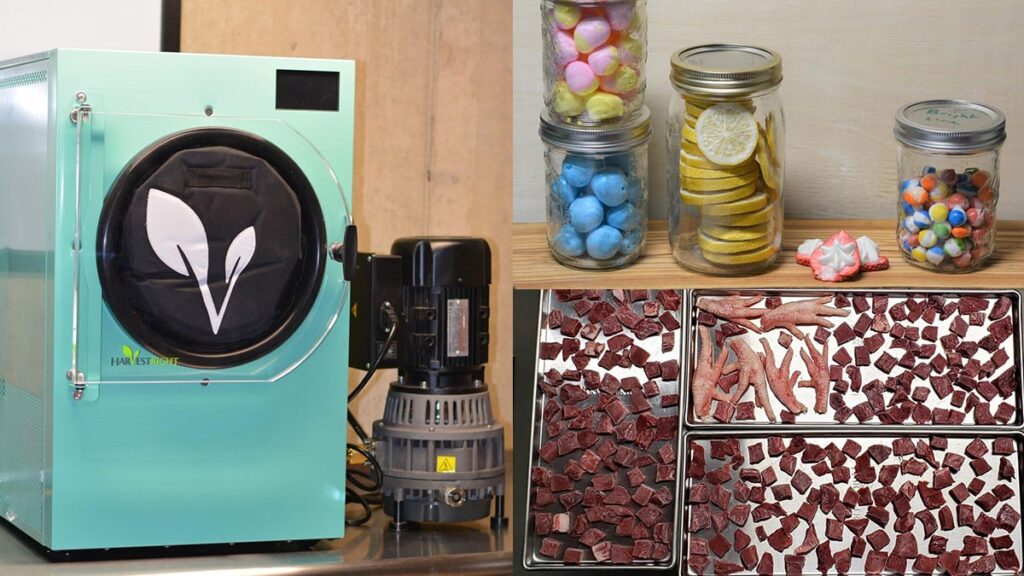
If you are thinking about buying a Harvest Right freeze dryer to save money and build the home food supplies needed to provide food security for your family, this is the article you want to read before investing the money. I both spoke with the folks at Harvest Right for this article and I polled people who have been using these units for years via my social media channels, so you are going to get more information than you might otherwise find on Harvest Right’s website.
I can tell you now that making your own freeze dried foods at home with a freeze dryer can either become a big waste of money or a brilliant cost saver that you will wish you had started doing sooner. An at-home freeze dryer can easily become like a piece of exercise equipment. You buy it all excited at first, start off with a bang, but slowly, steadily, the treadmill or elliptical machine become more of a clothes hanger than anything else. This can be the fate of many home freeze dryers, so first and foremost you are going to have to be realistic about how much you’re actually going to use the device.
I’ll help you sort through all of that, however. Here you can learn about what goes into freeze drying food, how these units work, and we will end with a comprehensive breakdown of the costs to benefits.
One User’s Experience
One of the big benefits of operating a large prepper website like this is the ability to reach out to readers for their feedback on different products. As you can probably imagine, personal freeze dryers are a big hit among preppers. One reader, Terry, was particularly helpful in his feedback of the Harvest Right machine he has been using.
I keep my Harvest Right freeze drier in the basement to mitigate some of the noise from the vacuum pump, and partly because it is cooler down there and I have a dedicated power receptacle and chest freezer down there as well. There are different vacuum pumps and each has a varying degree of loudness, the vacuum pump is loud but not so loud you can’t stand it.
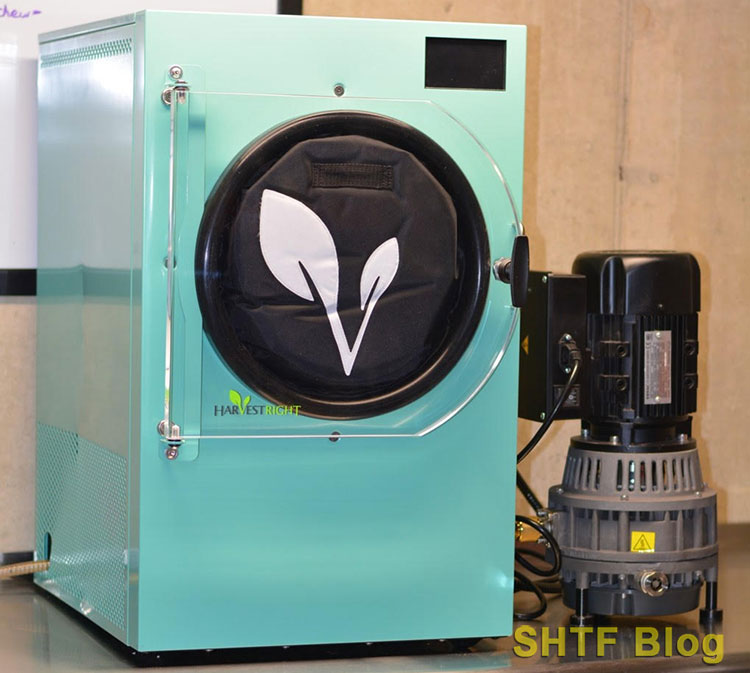
This is my freeze dryer, it was months and months to receive it and at one point Harvest Right contacted me and wanted to know if I would accept a black or white model. I declined as I originally wanted a red one, but they were unable to oblige at the time, so I went with this color which was discontinued before I even received it.
That said, it arrived with tiny dents from shipping, it didn’t affect the operation of the machine at all. But I knew they had already discontinued my color and it took months to receive it so I knew if I sent it back for some minor dents in the side I’d be waiting even longer and who knows what I’d have gotten since that color is no longer made.
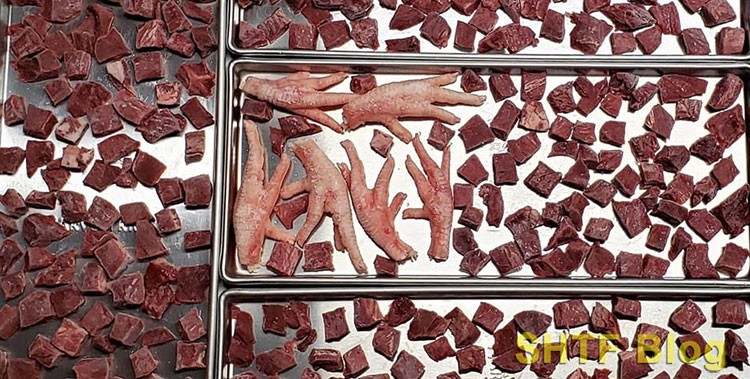
The basics: A freeze dryer first freezes the item down to about -40 degrees (you can pre-freeze items to jump start the process). Once it reaches -40 degrees the vacuum pump turns on and the orange heaters attached to the rack inside the vacuum chamber starts to slowly heat the food. As the frozen food crosses from solid to vapor it the vacuum pump sucks out the water vapor and it sticks to the inner walls of the freezer.
When done the machine will go into final dry, and will eventually stop when complete. The inner machine wall will be covered in ice from the moisture from the food, the food will feel warm to the touch – if it is cold it either still has water in it or has sat inside the machine for too long after the machine completed the final dry cycle, in either case the machine will need to be given more dry time to remove or warm the food before it is packaged. It can then be vacuum sealed in canning jars or packaged in Mylar bags with oxygen absorbers.
Other Users’ Experiences
Other people who have already own Harvest Right freeze dryers chimed in to add their experiences. These are some of the responses:
“Love mine. But wish I could rent it out. There is a lot of down time. Once you have a supply it tends to sit for long time periods.” I then asked her she thought it was worth it and she replied, “Yes, because I can put up what I want. Like steak and almond milk and fruit and veggies. The prepackaged meals tends to be pasta rice things like that I don’t really eat.”
“I am not sure the cost of upkeep is worth it. Lots of down time and money.”
Biggest selling point is for people with specific allergies or dietary needs, try finding gluten free freeze dried foods, or your grandma’s famous casserole.
“We have one, I don’t get to use it as much as I’d like due to my job having forced overtime. But the unit works as expected, we have the oil-less vacuum pump and have had no problems with the machine at all. We’ve freeze dried tomatoes, pineapple, apples, candy, lemons, beets, beef stew, spaghetti with Italian sausage, beets, chicken, eggs – all with no problems. I like the machine, I just feel due to time constraints I’m not using it to its full potential.”
What Goes Into Freeze Drying Food?
Freeze drying is the process of removing water from food in order to make it last longer. Its scientific name is lyophilization, and FDA defines it as:
Lyophilization or freeze drying is a process in which water is removed from a product after it is frozen and placed under a vacuum, allowing the ice to change directly from solid to vapor without passing through a liquid phase.
This process is broken down into three different processes: freezing, primary drying, and secondary drying. Another way of looking at this is a process of dehydrating the food at a low temperature, lowering the pressure, and then removing the ice that has formed. That last step is done via sublimation.
That is what sets freeze drying apart from dehydrating food. The water is first converted to ice and then to vapor. The vapor is then removed so it doesn’t merge with the food again. Freeze drying removes much more water than dehydrating food because of that sublimation process.
What was once a process reserved for large-scale commercial endeavors can now be performed at home. We have covered freeze drying in more detail in our article A Prepper’s Guide to Freeze-Dried Foods.
A domestic freeze dryer goes through the same water-removing process described above just on a small scale.
- You select the foods you want to freeze dry and place them on shelves that go inside the machine.
- Seal the chamber.
- Press the unit’s start button.
- Wait until its done.
- Place the finished food in an airtight container (such as a Mylar bag), add an oxygen absorber, and you’re done!
See Harvest Right’s own video walkthrough:
What is the Machine Doing?
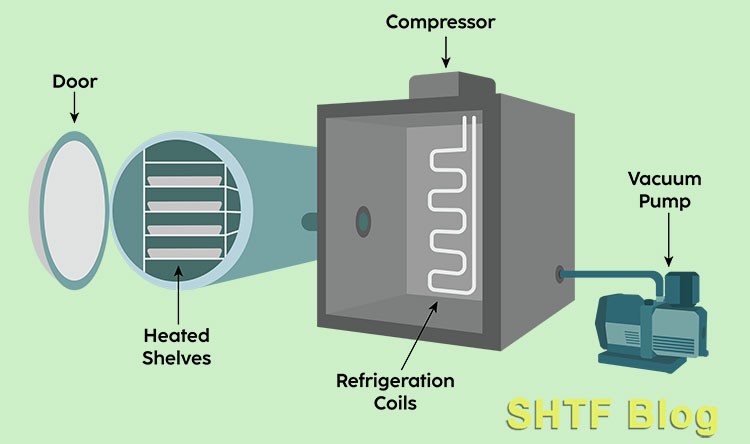
What happens inside the machine once you hit start is the machine’s compressors start up to lower the temperature and begin the freezing process. When the food freezes the water is separated (on a molecular level) from everything else.

The home freeze drying process has 3 stages: Freezing Cycle, Main Drying Cycle, and Final Dry.
In the Freezing Cycle the unit is set for a default 9 hour freeze. That preset time can be adjusted to your food. (Note: you can speed up this step by placing the food in your home freezer to start, what I call a pre-freeze freeze.)
Then the vacuum pump kicks on in the Main Drying Cycle. The chamber will get even colder now, down to -50 degrees Fahrenheit or more. Then the heating unit then kicks just enough to turn the ice into vapor. That vapor freezes to the sides of the chamber, permanently separating it from the food. This process repeats until as much water has been retracted from the food as possible.
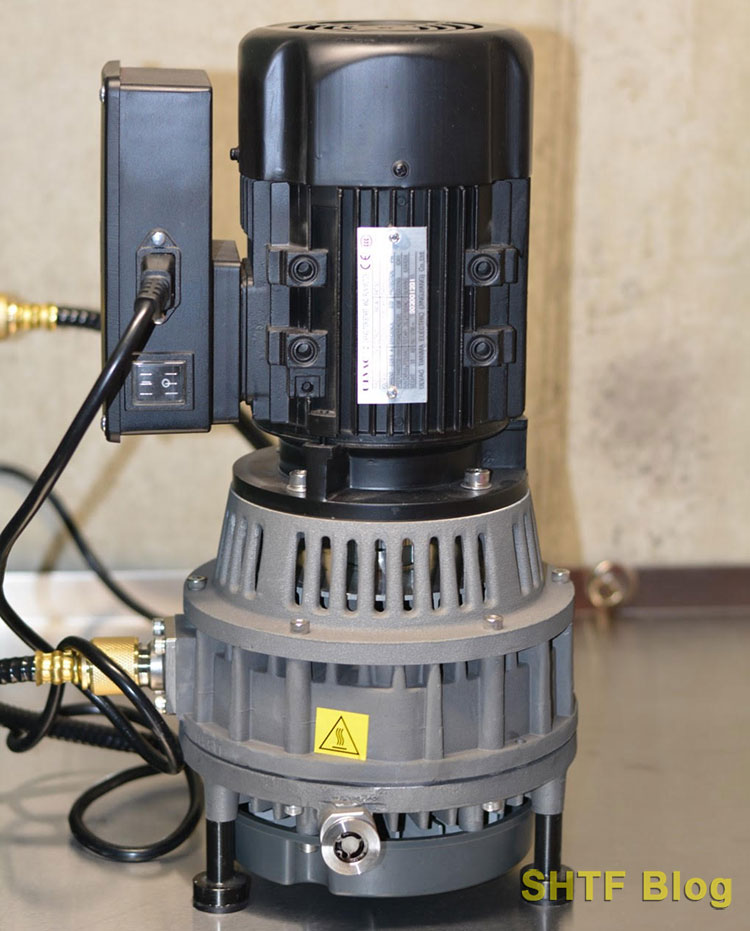
The Final Dry Cycle is the last step when the internal pressure increases more to extract every last drop of water possible out of the food.
That is all happening behind the scenes, however. It is nothing you have to manage. The Harvest Right machines are surprisingly simple to use. Really, it’s just setting your food in the machine, pushing the button, and waiting for it to finish. Don’t try to do freeze dry too much food at once. Stay conservative.
How Much Does a Freeze Dryer Cost?
The freeze dryer will cost between $2,195 and $4,890 depending on the size of the unit and the pump you choose. Factor in a cost of around $30 per month in electricity depending on how much you use it.
The following chart specifies their three sizes of home freeze dryers, with specs.
| Harvest Right Home Freeze Dryer | With Premier Pump | With Oil-Free Pump | Dimensions* | Food per Batch** |
|---|---|---|---|---|
| Small | $2,295 | $3,790 | 25″ H x 16.5″ D x 18.5″ W and 61 pounds* | 4-7 pounds** |
| Medium | $2,895 | $4,390 | 28.5″H x 18″ W x 21.25″ D and 112 pounds* | 7-10 pounds** |
| Large | $3,595 | $5,090 | 30.75″ H x 20.25″ W x 23.75″ D and 138 pounds* | 12-16 pounds** |
*Note: Weights do not include external pumps, which range between 18 and 42 pounds.
**Maximum annual output is 195 gallons of food for the small unit, 312 gallons for the medium unit, and 546 gallons for the large unit.
All models also come with the following: stainless steel trays, freeze drying guide, Mylar bags, O2 absorbers, and an Impulse Sealer.
What About the Electricity?
As noted in the price above, a home freeze dryer is going to require some serious electricity to run. The small and medium-sized until will run on a 110 volt outlet. The large unit calls for a 110 volt NEMA 5-20 outlet and a dedicated 20 amp circuit. If you skip this step you could encounter tripped breakers mid-process.
Now, in terms of hourly energy use, your home freeze dryer should draw about 16 amps, but on average between 9 and 11 amps per hour. As mentioned above, anecdotal evidence puts the increase in your electric bill at up to $30 a month during peak times, but of course that depends on how much you use it and what you pay for electricity rates.
Harvest Right Freeze Dryers
Harvest Right, based in Utah, has really cornered the market on domestic freeze dryers and for good reason. They make a great product. The three sizes they offer can cover the needs of most American families. The fact that they also carry commercial-grade and pharmaceutical freeze dryers speaks to their expertise in the market. They are all operated with a touch screen making them very user-friendly.
Their 3 Units
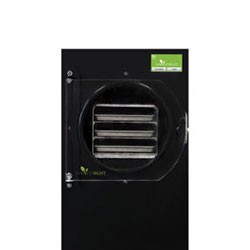
Small
- Cost: $2,195 – $3,690
- Batch Size: 4-7 pounds
- Dimensions: 25″ H x 16.5″ D x 18.5″ W
- Weight: 61 pounds
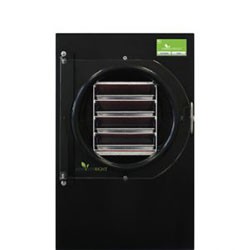
Medium
- Cost: $2,695 – $4,190
- Batch Size: 7-10 pounds
- Dimensions: 28.5″H x 18″ W x 21.25″ D
- Weight: 112 pounds
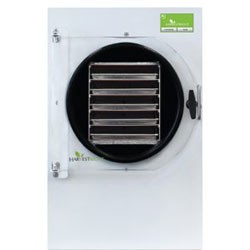
Large
- Cost: $3,395 – $4,890
- Batch Size: 12-16 pounds
- Dimensions: 30.75″ H x 20.25″ W x 23.75″ D
- Weight: 138 pounds
These above units different quantities of food, as evidenced by their varying batch sizes. To help visualize this, here are their respective internal tray sizes:
Note: Harvest Right freezer driers are also available at the Ready Store.
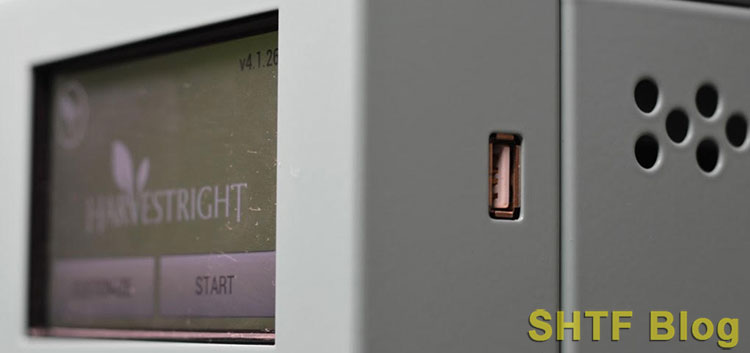
Harvest Right Return Policy and Warranty
Harvest Right’s customer guarantee includes a money back guarantee if you cancel your order prior to shipment (minus a 3% fee to cover any charges). One your new freeze dryer ships, you have 30 days to request a refund (minus shipping costs and 15% restocking fee). You can get your money back minus fees within the first 30 days, but it can be an expensive return, so best to make sure you want to buy it in the first place.
Their full one-year warranty is for the continental 48 states and extends from the ship date. Exclusions include the oi vacuum pump, which comes with a 6-month warranty. During this warranty period Harvest Right will replace or repair your unit.
Their three-year limited warranty also extends from the ship date. Here they will cover repair or replacement of the refrigeration system.
Is a Freeze Dryer Worth the Cost?
A freeze dryer is worth the cost if you for anyone who wants to create large amounts of freeze dried foods for emergency preparedness, outdoor activities, and general household consumption.
There’s no doubt, a home freeze-drying machine is a major purchase. With the average unit going for well over a few thousand dollars, plus the cost of supplies and electricity, make a smart decision.
Yes – Buy One or No – Don’t
These pros and cons might influence your decision making:
Yes – Buy One
- You want significantly more freeze dried foods in storage
- You want to make your own choices on the foods you find best for long-term storage
- Spending the money will not be a financial pain
- You do enough outdoor activities where you can eat the food your dry
- You want the reassurance of having foods with 25-year shelf lives
- You have the time to go through the process of drying your food
- You have a garden or access to plenty of foods that just can’t otherwise eat fast enough
No – Don’t Buy One
- The get nervous about the idea of spending too much money
- You do not realistically think you will use it enough to justify the cost
- You don’t have ready access to foods for freeze drying
- You have to borrow money to buy one
- You’re just a single person without enough mouths to make it worthwhile
What you’re going to add up on the “benefit” side depends on your household and your goals. If you’re someone who wants to “hope for the best, prepare for the worst,” you may find buying a home freeze dryer is a great investment.
The creative person might also consider doing what this woman did and making high-end freeze-dried products to sell locally. It could help offset the cost of your unit and turn a profit.
Comparing Home Freeze Drying Costs to Buying Freeze Dried Food Outright
You may think you’ll save a lot of money by freeze drying your own food, and you will, but only if you do a fair amount of it to make up the cost of the unit itself. What costs $20-$50 in the form of a #10 can of freeze dried food might cost $6 to $15 when you do it yourself. These are only estimates, however. Here are the factors that go into how much you will save freeze drying yourself:
- Whether you have to buy the food you are freeze drying or getting it from your garden
- If freeze drying your food means you can make better use of left overs or unused foods
- How much you use the unit
- How much freeze dried food you consume
- How much your electricity costs are
- If you can buy enough Mylar bags and oxygen absorbers in bulk to reduce costs
Advantages vs Disadvantages of Buying a Freeze Dryer
Everything comes with its pros and cons and freeze driers are no exception. Consider the following before buying one.
Advantages
- Greater independence
- Another food storage technique at your disposal
- Preserve more food for less total money (when used regularly)
- Longer shelf life for your food (up to 25 years)
- Greater nutritional value of stored food (97% of original nutritional value)
- User friendly unit
Disadvantages
- Expense of the machine
- Noise (a freeze dryer can be loud enough that you want it somewhere that it won’t disturb you)
- Slow process
This video will help break down the costs/savings associated with store bought freeze dried food vs doing it at home:
FAQs
This set of frequently asked questions are answered based on research, user experience, and direct correspondence with Casey Cummings, Harvest Right’s Online Marketing Manager.
Why Are Home Freeze Dryers So Expensive?
In layman’s terms, the process of sublimation requires temperatures of near negative 40 degrees Fahrenheit, as well as a complete vacuum environment. No air can enter or leave that subzero chamber. That, in turn, makes it necessary for the home freeze-drying machine to be built literally airtight, and that kind of engineering doesn’t come cheap.
How Long Does A Freeze Dryer Last?
Beyond the first few months, the period during which any defective part will most likely rear its ugly head but be covered by warrantee (and Harvest Right offers 3-year protection), the main thing to watch with regard to your machine’s longevity is the care you take for the vacuum pump. If it’s maintained well, it can last for years. The vacuum pump is the number one replacement part needed for Harvest Right’s machines, which are, in the words of Ms. Cummings, themselves “built to last.”
How Long Before Earning Your Money Back?
On average, according to Ms. Cummings, within six months to a year you will likely have stored away food to earn your money back. Whether this holds true or not depends on how much you’re drying and consuming.
Can You Just Freeze Dry Food at Home Without a Machine?
Technically, the answer is yes. Some bloggers, even some experts, suggest ways to freeze dry food with just your fridge’s freezer or a bucket with dry ice. But in these cases, the sublimation (drying) part of the process takes a long time, up to weeks for a single batch of food.
There’s a lot of room for error, and these methods to me seem like more of a novelty than a serious way to build up your long-term food store..
Isn’t Freeze Drying Just Like Dehydrating?
To answer this, let’s once more refer to the words of Harvest Right’s Casey Cummings:
Many [people] confuse freeze dryers with dehydrators. They … are both ways to preserve food, but in almost all other ways they are very different. Freeze drying is able to preserve the nutrition of food because it removes the water from food at -40° to -50°, whereas dehydrating uses heat to remove the water from food, which destroys about half of the food’s nutrition.
Plus, freeze drying allows you to preserve full meals, all of your own recipes of casseroles, soups, [plus] raw and cooked meat that can be rehydrated to be like they were fresh. You can do all of your dairy products like cheese, yogurt, ice cream, and even cheesecake. And, all of it will last up to 25 years (10-15 for meat, 25 for everything else).
Casey Cummings, Harvest Right Online Marketing Manager
What Kind of Foods are Best to Freeze Dry?
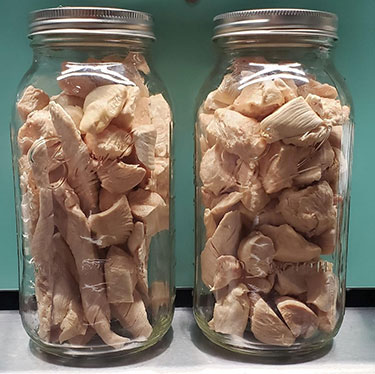
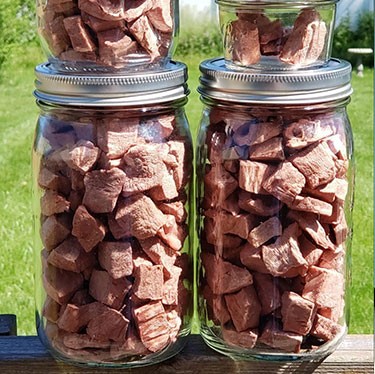
Small fruits and vegetables that are the easiest food items to freeze-dry. Some examples include:
- olives
- corn
- beans
- peas
- berries
- pineapple chunks
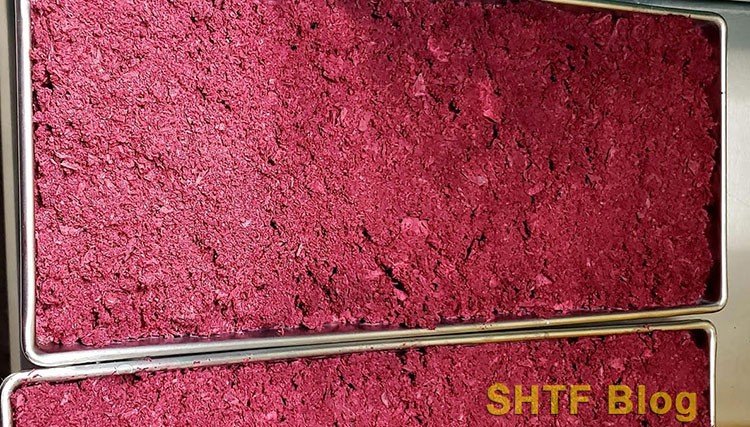
If you’re more interested in the “good stuff,” you can also freeze dry:
- crab
- lobster
- beef
- shrimp
- chicken
- candy
- and much more
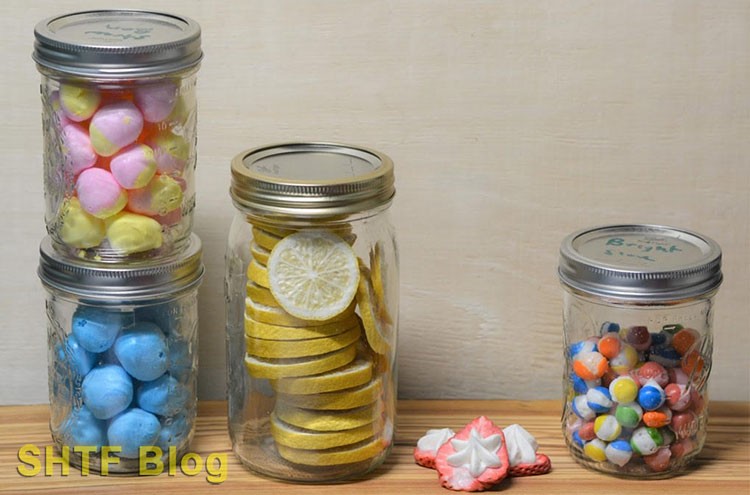
Of course, you are not limited to single foods. Much like Mountain House meals you can buy in freeze dried form, you can opt to freeze dry recipes you make.
What Foods Cannot be Freeze Dried?
Remember, freeze drying works by removing water from foodstuffs; the oil is left in them. That makes oil-rich foods a bad bet for freeze drying. Foods you don’t want to freeze dry include chocolate, peanut butter, honey, syrup, and jam. We don’t know about frosting, for those of you who like to sneak a finger-full out of the fridge from time to time, but we wouldn’t bet on it. Stick to the tried and true, which in most cases is better food anyway.
Are There Hidden Costs
Fortunately, the Harvest Right freeze dryers come with free shipping, but there are no “hidden” costs to consider beyond the unit itself and the additional electricity needed to run them. These costs are in the additional Mylar bags, oxygen absorbers, and oil for the vacuum pump. How much exactly depends on how much food you are freeze drying. Here are the products to give you an idea:
- Excellent barrier properties to Oxygen and Moisture. These are metalized bags, they are not subject to pinholes and will work perfectly if scrunched, rolled, or balled up!
- Use 1-2 300cc oxygen absorbers per bag. Seal the bag a full 2" to prevent air infiltration.
- These are strong but economical bags, particularly when storing for a shorter period of time (5-7 years).
- Heat seal using a standard clothing iron, impulse sealer, or clamshell sealer. A Food Saver may seal these bags, but will not vacuum them.
- BPA Free Mylar Bags.
- Package Dimensions: 7.874 cm (L) X 8.89 cm (W) X 22.86 cm (H)
- Package Type: Auto Oil
- Package Quantity: 1
- Country Of Origin: United States
- Model Number: V32
Mind you, changing the oil might be more frequent than you think. Harvest Right recommends draining off 1-2 tbsp of oil at the beginning of each batch, changing the oil completely after every 5-6 batches, and power flushing the entire thing every 10-12 batches. The reason for this level of maintenance is because as the vacuum pump runs, small amounts of water will accumulate in the pump. That water adds to the oil level requiring drain off and flushing.
Conclusion
If you’ve already spent thousands of dollars on freeze dried foods from suppliers and see yourself spending even more, why not bite the bullet and get yourself the means to freeze dry your own meat, dairy, and produce?
If you can afford it and will put it to good use, buying a freeze dryer is worth the cost.
Look closely into purchasing that freeze-dryer. If you’re in the market for one, compare the prices at both Harvest Right and Ready Store. Prices and sales may vary.
Your thoughts? Let us know in the comments section.





11 comments
Great article. Thank you for the education.
Single, rural homestead. Planted 22 fruit trees, multiple berry/bramble/grapes and either can or freeze dry. Grow 90% veg and can tomatoes, beets but freeze dry peas, carrots, broccoli, corn, etc. Probably overkill for single homesteader but freeze drying, canning and frozen allows me to have multiple backup plans for preserving my harvests. I freeze dry meat stock, coffee creamer, milk, cheeses, herbs. I powder some veg and make up “soups in a jar”. I have off grid solar to power freezers but if EMP, I wanted to make sure I had preps other than frozen foods. I can substantial meats (stew meat, ground beef, lots of chicken) but freeze dry eggs, veg, fruit and prepared meals. To help justify cost, I offer freeze dry items along with fresh at the farmers market. I also feel I could barter with freeze dried items. So it’s really a question of whether you have the $$$ as I don’t see a single other reason not to buy.
Tulips,
Does your dryer “sweat” a lot?,,,,,water actually dripping off the glass?
Do you have to remove the trays and dry the vacuum chamber after EVERY batch? I’m in my learning curve.
Ken
Upstate SC
Condensation is a natural response to two areas with different humidity/temps. SC is like TN and often humid during peak summer months. Yes there is condensation, I keep a dray under the HR to collect. Nothing to be concerned about. When peak freeze drying with back to back batches – I will defrost and often add an hr to make sure it’s quick. Otherwise, I merely allow to naturally defrost with door opened a bit and drain plug open.
Great info!
Wonder if it would be possible to actually speak to a user? I’m new at the process and would like to ask a couple of questions. I’ll gladly share my cell number if anyone is available.
Ken
Upstate SC
Hi, Ken. Was the manufacturer able to help? They should be your source.
We’ve had a HarvestRight medium freeze dryer for several weeks and keep it running all the time. We have two sets of trays so we can pre-freeze the next batch while one batch is drying. We freeze dry only fruits at present to assure we will have many months of fruits available (with the living enzymes intact and with natural taste and texture) during an extended disaster. Our yield is about 15-20 servings of bananas or apples per batch and we pack them in 1 gallon mylar bags with two 500 cc oxygen absorbers. It takes very little time each day to slice bananas and apples, maybe 15 minutes at the most. Who cares about the cost of the unit or the cost of the electricity if one is concerned about having plenty of living food available during extended periods of disaster?
Sam – you may want to explore freeze drying raw eggs – 15 to a medium tray. Also if you don’t have veg to harvest, you can freeze dry store bought frozen. that way you’re stocking up eggs and veg as well. Also freeze dry cheese – store bought shredded.
I have many allergies and I got my Harvest Right a year ago. None, and I mean none, of the emergency food suppliers provide food that I can actually eat. So I bought a Harvest Right. I love it. I grew a large garden last year and I was able to freeze dry everything from my garden that I couldn’t eat right away. I have solar on my home so the electricity use is not an issue, it hasn’t raised the cost of my electric bill ($0) at all. I have found that I use my freeze dryer a lot, even this last winter I used it about once a week. It’s perfect for preserving leftovers.
I also love to camp and my family loves to backpack. This food is perfect for those activities. I’m looking forward to bringing my freeze dried food camping this year! And I know that if an emergency hits, I have food that I can actually eat.
We had bad experience with our unit. arrived with wiringharness detached. worked for three weeks and then had vacuum issue, which was resolved but immediately followed by a failure to cool error. Harvest Right had it shipped back for repair. no response or update for three months, and it took a month to diagnose and troubleshootbefore they authorized the warranty return. when it did work the foods we preserved were excellent.
just got harvest right freeze dryer, accidentally hit the wrong button it canceled the batch time, I can’t find a way to restart it with just dry time? Do I need to let it completely restart? (there is no option that I can find )
Thank you